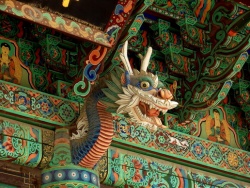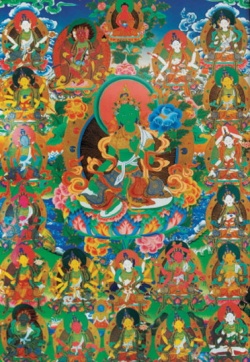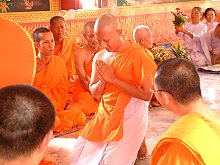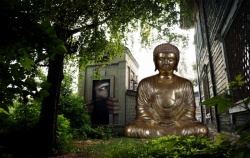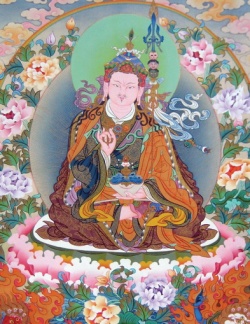Difference between revisions of "Five teachings and ten doctrines"
| Line 1: | Line 1: | ||
| − | [[File:0bcd0 b.jpg|thumb|250px|]] | + | [[File:0bcd0 b.jpg|thumb|250px|]]<nomobile>{{DisplayImages|813|2451|3717|2959|1841}}</nomobile> |
Revision as of 19:56, 3 January 2016
five teachings and ten doctrines
五教十宗 (Jpn gokyo-jisshu )
A classification of Buddhist sutras set forth by the Chinese Flower Garland (Hua-yen) school . Fa-tsang (643-712), the third patriarch of the school, established this classification.
He classified the sutras into five groups according to the level of their teaching, and the Buddhist schools into ten groups according to their doctrines .
The five teachings are
(2) the elementary Mahayana teaching,
(3) the final Mahayana teaching,
(4) the sudden teaching, and
"The Hinayana teaching" corresponds to the Agama sutras . These teachings set forth the four noble truths and the twelve-linked chain of causation .
They also hold that, while the self has no independent existence of its own, the dharmas (elements of existence) are real.
"The elementary Mahayana teaching" is divided into two: the teaching that analyzes the specific and distinct characters of the dharmas , and the teaching that regards all dharmas as non-substantial.
The former is found in the Revelation of the Profound Secrets Sutra , and the latter in the Wisdom sutras.
"The final Mahayana teaching" maintains the essentially unchanging nature of all things and the ability of all beings to attain Buddhahood .
This teaching is found in the Lankavatara Sutra and The Awakening of Faith in the Mahayana .
"The sudden teaching" expounds the abrupt realization of the ultimate truth without relying upon verbal explanations or progression through various stages of practice.
This teaching is found in the Vimalakirti Sutra .
"The perfect teaching" indicates the Flower Garland and Lotus sutras , which expound the one vehicle.
"The perfect teaching" is further divided into two: the one vehicle of the identical doctrine and the one vehicle of the distinct doctrine .
The former is the one vehicle that is identical in part to the other teachings, the final Mahayana and the sudden in particular, and corresponds to the Lotus Sutra .
The latter is the one vehicle that is entirely distinct or separate from the other teachings, and corresponds to the Flower Garland Sutra .
The one vehicle of the distinct doctrine is held to be superior to that of the identical doctrine .
Hence the Flower Garland school asserts that the Flower Garland Sutra is superior to all the other sutras .
The ten doctrines are:
(1) The doctrine of the reality of both the self and the dharmas . This is espoused by the rather unorthodox Vatsipu-triya school.
(2) The doctrine that the self is non-substantial but the dharmas are real, and that the past, present, and future exist independently. This is the position of the Sarvastivada school.
(3) The doctrine that the reality of the dharmas exists only in the present and not in the past or the future, which is upheld by the Mahasamghika school.
(4) The doctrine that the present contains both reality and unreality. That is, the five components of life are real, but the six sense organs, six sense objects, and six senses are temporary, or unreal. The Prajnaptivadin school holds this position.
(5) The doctrine that worldly truth is unreal, but that Buddhist truth is real, taught by the Lokottaravada school.
(6) The doctrine that all things and phenomena are mere names without self -nature, taught by the Ekavyavaharika school. The first six of the ten doctrines correspond to the first of the five teachings, that is, the Hinayana teaching.The remaining four doctrines belong to Mahayana :
(7) The doctrine that maintains the non-substantiality of all things. This doctrine corresponds to the elementary Mahayana teaching and is found in the Wisdom sutras .It is also the view of the Three Treatises (Chin Sanlun ) school.
(8) The doctrine that recognizes an unchanging truth that is the essence of all things. This doctrine corresponds to the final Mahayana teaching and is espoused by the T'ient'ai school.
(9) The doctrine that the truth lies in the mystic realm beyond the polarity of subject and object. This doctrine corresponds to the sudden teaching and is found in the Zen , or Ch'an , school.
(10) The doctrine that all things exist in perfect harmony and interrelation.
This doctrine corresponds to the perfect teaching and is found in the Lotus and Flower Garland sutras .
In particular, it indicates the doctrine of the Flower Garland school.
With this system of classification, Fa-tsang asserted the superiority of the Flower Garland Sutra over all the other sutras , and the doctrine of the Flower Garland school over those of all other schools.
